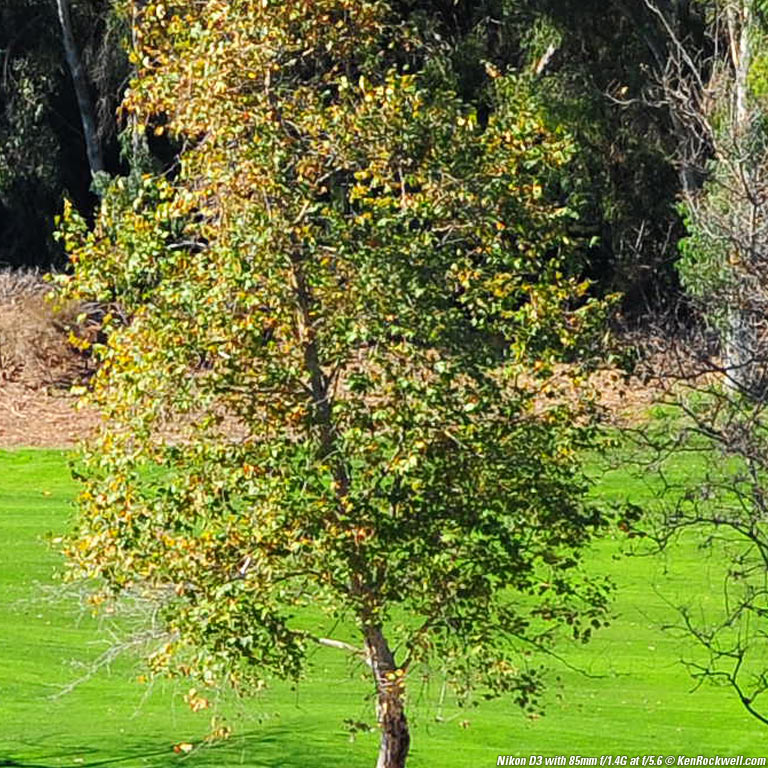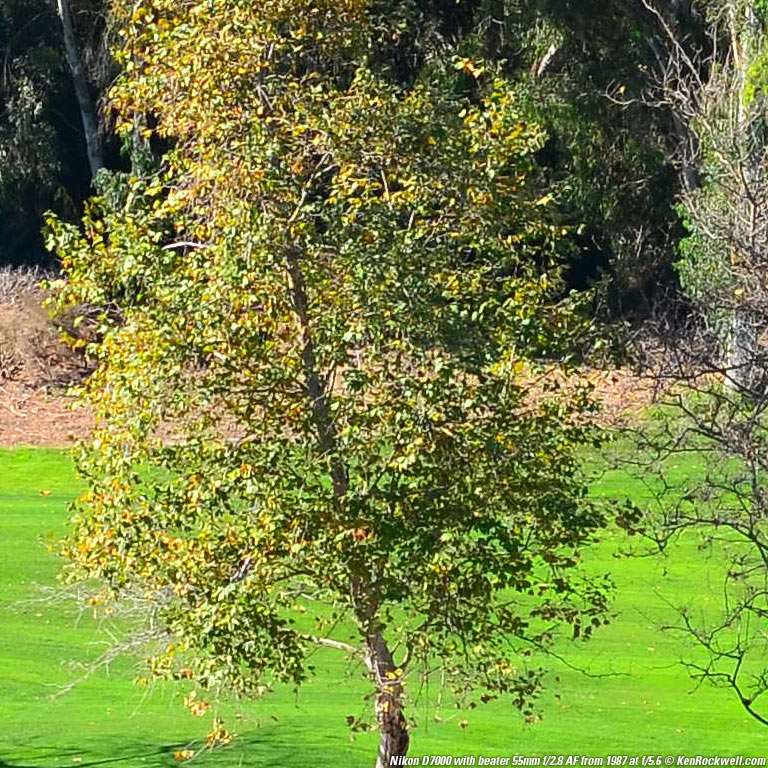Home Donate New Search Gallery How-To Books Links Workshops About Contact
Nikon D7000 Sharpness versus FX
© 2010 KenRockwell.com. All rights reserved.
November 2010 More Nikon Reviews Nikon Lens Reviews Nikon Comparisons
Introduction top
Let's compare the Nikon D7000 (16MP, DX) to Nikon's 12MP professional FX cameras.
In this case, I used a Nikon D3 (12MP FX), which has the same sensor as the D700, and the same resolution as the D3s.
I shot each with the sharpest lens possible, each with the same angle of view, and then show these greatly enlarged crops from identically-sized prints. These gallery-sized prints would be 50 x 33" (125 x 85cm), if printed in their entirety, as seen on a standard (100DPI) monitor.
Here goes. Roll your mouse over to compare:
Enlarged crops from gallery-sized prints. Roll mouse over to compare.
Here's the other image for you folks viewing on the Apple iPhone or iPod touch:

At smaller sizes, these differences would be less obvious.
The prints from which these crops are taken are over four feet wide; would you look at prints this big this close? Probably not.
Analysis top
It's clear that more pixels in the D7000 equals more resolution than fewer pixels in FX. Actually, I didn't expect it to be this obvious, and I used a 23-year-old beat-up plastic AF lens from 1987 on the D7000!
Most lenses used optimally will show this same difference between these cameras.
If you use lenses that aren't sharp enough to make use of either camera's maximum resolution, or use them improperly by stopping them down beyond f/5.6, then that's your fault, not the camera's.
Teknik top
These images are shown at the same size, shot from the same place, with lenses of equal angle-of-view, at the same aperture. These are huge enlargements: this synthetic reference vegetation is at 200 meters (600 feet)!
The same equivalent focal length was used for each camera, and I with the sharpest prime lens in existence for each camera: The 1987 Nikon AF MICRO-NIKKOR 55mm f/2.8 for the D7000, and the Nikon AF-S NIKKOR 85mm f/1.4 G for the D3.
The 55/2.8 MICRO-NIKKOR is the sharpest lens made for Nikon, and likewise, the 85mm f/1.4G, with the same angle-of-view on FX, is Nikon's sharpest 85mm lens. in both cases, either of these lenses is far sharper than the camera can show; we're seeing the camera's limitations here, not anything related to the test conditions or lenses.
Each was shot at the Daylight white balance setting. I turned off shadow and highlight optimization.
Picture Control was amped-out as I usually shoot: VIVID and +3 saturation, and sharpening at 6.
Each was shot at f/5.6 on a tripod, at each camera's standard ISO: ISO 100 for the D7000 and ISO 200 for the D3. At 200 meters (600 feet), f/5.6 is both the sharpest aperture for these diffraction-limited lenses, and the depth-of-field is more than enough for the very narrow range of subject distances seen here.
The D7000 image is shown at 100% pixel-to-pixel, and the D3 image is shown at the same size. The D3 file had to be enlarged about 15% to be the same size as the D7000 image; I used Photoshop CS5 (bicubic) to ensure a meaningful comparison.
To show each camera fairly, I used actual images directly from each camera. If I had shot raw data instead, I would have needed to process each file with software to turn that data into a visible image, which also would have shown differences in each piece of software's interpretation as well as differences between cameras. Unknown to most casual users is that even if I used the same software, say Adobe Camera Raw, it processes files from different cameras differently. By using real JPGs, we can see exactly what each camera is doing. Feel free to run your own experiments with raw data if you prefer. Sharper renditions will enhance detail, but exaggerate noise, and vice versa. Ditto for differences in letting Adobe or whoever do the noise reduction instead of the cameras themselves in JPG. If you want these results in raw data, shoot it yourself and please share with us the results as I do. Hint: As of today, 09 November 2010, Adobe Camera Raw can't read the D7000 raw files, which I had planned to use.
Help me help you top
I support my growing family through this website, as crazy as it might seem.
The biggest help is when you use any of these links to Adorama, Amazon, eBay, Ritz, Calumet and J&R and when you get anything. It costs you nothing, and is this site's, and thus my family's, biggest source of support. eBay is always a gamble, but all the other places always have the best prices and service, which is why I've used them since before this website existed. I recommend them all personally.
If you find this page as helpful as a book you might have had to buy or a workshop you may have had to take, feel free to help me continue helping everyone.
If you've gotten your gear through one of my links or helped otherwise, you're family. It's great people like you who allow me to keep adding to this site full-time. Thanks!
If you haven't helped yet, please do, and consider helping me with a gift of $5.00.
As this page is copyrighted and formally registered, it is unlawful to make copies, especially in the form of printouts for personal use. If you wish to make a printout for personal use, you are granted one-time permission only if you PayPal me $5.00 per printout or part thereof. Thank you!
Thanks for reading!
Mr. & Mrs. Ken Rockwell, Ryan and Katie.
Home Donate New Search Gallery How-To Books Links Workshops About Contact

